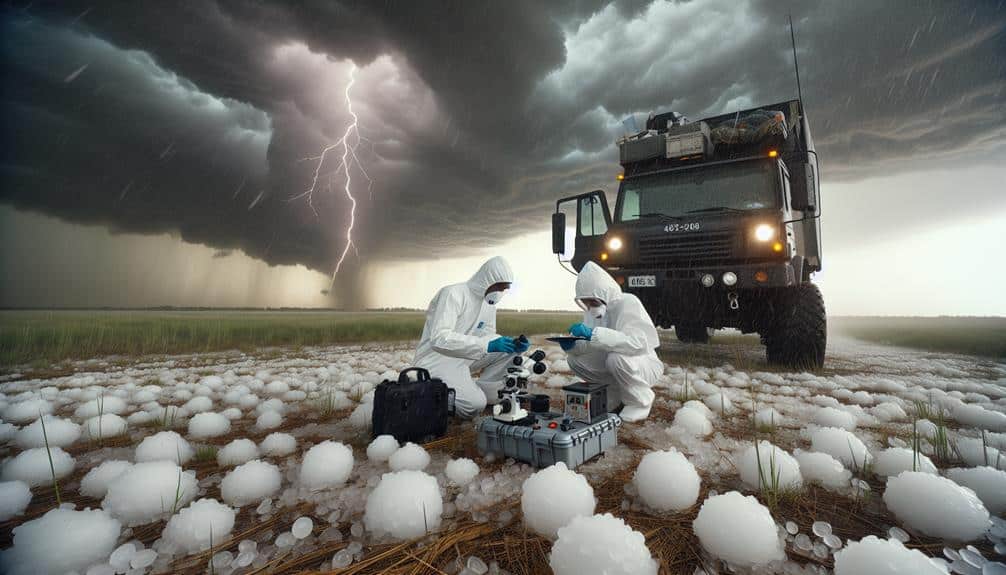We can utilize hailstorms for renewable energy by integrating seven key strategies. First, understand hailstorm dynamics to optimize energy capture. Second, select durable, efficient equipment that withstands extreme weather. Third, identify high-frequency hailstorm regions using detailed meteorological data. Fourth, prioritize safety with advanced protective gear and reliable communication systems. Fifth, establish thorough data collection methods, including drones and real-time monitoring. Sixth, use advanced analytics to interpret hailstorm data accurately. Finally, apply findings to develop robust, adaptable energy capture infrastructure. These innovative insights will help uncover the potential of hailstorms as a renewable energy source. For a more in-depth exploration, there's more to discover.
Key Points
- Select Durable Materials: Use durable materials and robust designs to withstand extreme hailstorm conditions and enhance the longevity of energy capture devices.
- Innovative Capture Technologies: Implement innovative solutions like hail netting and capture drones to efficiently harness energy from hailstorms.
- Analyze Meteorological Data: Use historical and real-time meteorological data to identify optimal locations with frequent and intense hailstorms for energy capture.
- Advanced Safety Measures: Ensure advanced protective gear and clear emergency response plans to safeguard personnel during hailstorm events.
Understanding Hailstorm Dynamics
Hailstorm dynamics involve the formation, growth, and path of hailstones within cumulonimbus clouds, driven by complex interactions between updrafts, supercooled water droplets, and varying atmospheric pressures.
As we explore hailstorm formation, the key is understanding these atmospheric conditions. Updrafts within the clouds play a vital role by lifting water droplets to altitudes where temperatures drop below freezing, forming supercooled droplets.
These supercooled droplets collide with other particles, initiating the growth of hailstones. Repeated cycles of upward and downward motion within the cloud allow these hailstones to accumulate successive layers of ice. The strength of the updrafts determines the size of the hailstones; stronger updrafts result in larger hailstones as they're suspended longer, gathering more ice.
Atmospheric conditions, including temperature variations, humidity levels, and wind shear, influence the path and eventual descent of hailstones. Understanding these variables empowers us to predict and utilize the energy within hailstorms.
Selecting the Right Equipment
To harness hailstorms effectively, we must focus on vital hail capture devices designed for efficiency and resilience. Selecting durable materials that withstand extreme conditions is important, as is implementing a robust maintenance and upkeep protocol to guarantee long-term functionality.
Let's explore the key equipment and materials that will enable us to convert hailstorm energy reliably.
Essential Hail Capture Devices
Selecting the finest hail capture devices requires a nuanced understanding of aerodynamic principles and material science to ensure efficiency and durability. In our quest to harness the raw power of hailstorms, we must consider innovative solutions like hail netting and capture drones.
Hail netting is a fundamental component in our arsenal. By setting up a robust network of these nets, we can effectively intercept hailstones, minimizing their kinetic energy before they reach the ground. The key here is to design nets with the best mesh size and tensile strength, ensuring they can withstand the impact of hail without tearing. Additionally, strategically positioning these nets to align with prevailing wind patterns maximizes their capture efficiency.
Capture drones represent the frontier of hailstorm energy harnessing. These autonomous devices are equipped with advanced sensors and AI to track and intercept hailstones mid-air. The drones' aerodynamic design allows them to maneuver swiftly and precisely, capturing hailstones in real-time. By integrating real-time data analytics, these drones can predict hail trajectories and adjust their flight paths accordingly, achieving unparalleled efficiency.
Together, hail netting and capture drones embody the cutting-edge of hail capture technology, allowing us to transform nature's fury into a renewable energy source.
Durable Material Selection
Securing that our hail capture devices operate efficiently hinges on selecting materials that offer superior durability and resilience against the intense forces generated by hailstorms. To achieve this, we must focus on material durability and weather resistance. These characteristics are essential for withstanding the relentless barrage of ice pellets without compromising structural integrity.
First and foremost, we should consider impact-resistant materials like polycarbonate and high-quality aluminum. Polycarbonate, with its high tensile strength, can absorb and disperse the kinetic energy from hailstones, reducing the risk of fractures. High-quality aluminum, meanwhile, combines lightweight properties with exceptional corrosion resistance, making it ideal for long-term exposure to harsh weather conditions.
Longevity considerations are equally critical. Using materials that degrade slowly even under extreme weather secures our systems remain operational for extended periods. Advanced composites and treated metals can offer the necessary durability to endure multiple storm seasons without significant wear and tear.
Incorporating these materials not only enhances performance but also minimizes maintenance costs. This strategic selection liberates us from frequent replacements and repairs, allowing us to focus on innovation and efficiency. Ultimately, choosing the right materials is pivotal for creating a resilient, sustainable hail energy capture system.
Maintenance and Upkeep
By utilizing state-of-the-art diagnostic tools, we can proactively monitor and maintain our hail capture devices to ensure peak functionality and longevity. Advanced sensors and real-time data analytics enable us to identify wear and tear before it becomes problematic. This proactive approach minimizes downtime, guaranteeing our systems are always ready to harness the power of hailstorms efficiently.
When selecting equipment, we must prioritize reliability and ease of maintenance. Opting for modular designs simplifies equipment maintenance, allowing us to replace or upgrade components without extensive downtime. Additionally, integrating automated self-cleaning mechanisms can prevent debris buildup, further enhancing system efficiency.
Safety precautions are paramount. We need to make sure that all maintenance procedures are clearly documented and that our teams are thoroughly trained. Regular safety audits and compliance checks help mitigate risks, safeguarding both personnel and equipment. Implementing remote monitoring systems can also reduce the need for on-site interventions, thereby minimizing potential hazards.
Incorporating these practices not only extends the lifespan of our hail capture devices but also maximizes their energy output. By staying ahead in equipment maintenance and safety protocols, we empower ourselves to harness hailstorms as a reliable and sustainable energy source.
Identifying Ideal Locations

To identify the best locations for harnessing hailstorms as a renewable energy source, we must analyze meteorological data with precision to pinpoint regions with high hailstorm frequency and intensity. We'll explore geographical data and climate patterns to distinguish the areas most suited for our innovative energy capture systems. By understanding these patterns, we can maximize energy yield and efficiency.
Storm tracking and remote monitoring technology are essential tools in this venture. They allow us to gather real-time data on storm development and movement, necessary for selecting ideal sites.
Here's how we can effectively leverage these tools:
- Geographical Data Analysis: We need to examine historical hailstorm data to identify hotspots.
- Climate Pattern Studies: By understanding seasonal and annual climate variations, we can predict hailstorm occurrences more accurately.
- Advanced Storm Tracking: Using radar, satellites, and other tracking technologies, we can monitor storm paths and intensities in real-time.
- Remote Monitoring Systems: Deploying sensors and observation stations allows continuous data collection and analysis, enhancing our prediction models.
Safety Measures for Storm Chasers
As storm chasers, we must prioritize wearing advanced protective gear to shield ourselves from hail and extreme winds.
Our emergency response plan should include real-time communication systems and pre-determined evacuation routes to guarantee our safety.
Protective Gear Essentials
Safeguarding our safety while pursuing hailstorms requires a meticulous selection of protective gear, designed to withstand extreme weather conditions and minimize risks. As storm chasers, our freedom to explore the raw power of nature depends on our preparedness. Proper protective gear selection, coupled with continuous weather monitoring, is essential.
First and foremost, our gear must offer robust impact resistance and meet stringent visibility requirements. Here's what we need:
- Helmets with Face Shields: Essential for protecting against hail impact, these helmets should be high-impact resistant and include face shields for full facial protection.
- High-Visibility Clothing: Severe weather can drastically reduce visibility. High-visibility jackets and pants with reflective strips ensure we remain visible to our team and emergency responders.
- Sturdy Footwear: Waterproof, insulated boots with non-slip soles are vital to navigate slippery terrains and provide ankle support.
- Weather-Resistant Gloves: These should offer both dexterity and protection against cold, wet conditions, and possible debris impact.
Emergency Response Plan
Equipped with the right protective gear, we must also establish a detailed emergency response plan to effectively manage potential hazards during hailstorm pursuits. A robust plan involves meticulous communication strategies and clear evacuation routes. We need to guarantee that our team maintains constant contact through reliable, weather-resistant communication devices.
Satellite phones, two-way radios, and GPS trackers are essential tools to stay connected and coordinate movements. Our communication strategies should include regular check-ins, predefined distress signals, and a central command point to manage all incoming and outgoing information. This centralized approach allows us to quickly disseminate updates about changing weather conditions, making sure everyone is informed and can respond promptly.
Evacuation routes are equally important. Before heading out, we must map out multiple exit paths from any given location. These routes should be reviewed and practiced regularly, making sure every team member knows them by heart. We also need to consider the possibility of blocked roads and have backup plans ready.
Data Collection Techniques

To effectively harness the power of hailstorms for renewable energy, we must employ cutting-edge data collection techniques that capture real-time meteorological and environmental variables. By leveraging the latest advancements in weather patterns and technology, we can gather precise and actionable data to drive our innovative energy solutions.
First, we need to deploy a network of advanced weather stations equipped with high-detail sensors. These stations will continuously monitor atmospheric conditions, providing us with invaluable real-time data.
Next, we should integrate satellite remote sensing technology. This allows us to collect extensive data on storm formation and movement, enhancing our understanding of meteorological phenomena.
Drones equipped with specialized instruments can play a pivotal role in capturing localized data. These agile devices can navigate through hailstorm environments, collecting detailed information on hail size, density, and distribution.
Lastly, we must utilize machine learning algorithms to analyze large datasets quickly and accurately. These algorithms will help us identify patterns and make predictive models to optimize our energy capture strategies.
Here's a summary of our key data collection techniques:
- High-detail weather stations
- Satellite remote sensing
- Drone-based data collection
- Machine learning algorithms
Analyzing Collected Data
Utilizing the vast datasets we've gathered, our next step is to employ advanced analytical techniques to extract actionable insights and enhance our hailstorm energy capture strategies. Data analysis allows us to identify patterns, correlations, and anomalies in the collected information. By delving deep into this data, we can understand the dynamics of hailstorm occurrences, their intensity, and their potential energy output.
Predictive modeling plays a pivotal role in this process. By using historical data and machine learning algorithms, we can forecast future hailstorm events with remarkable accuracy. These models enable us to anticipate hailstorm behaviors, thereby enhancing our energy capture systems' efficiency.
We need to integrate various data sources—meteorological, geographical, and atmospheric—to create inclusive models that reflect the complexity of natural hailstorm phenomena. With these predictive tools, we can refine our strategies, ensuring that our energy capture mechanisms are optimally positioned and calibrated.
Our commitment to data analysis and predictive modeling not only drives innovation but also empowers us to harness hailstorms as a reliable renewable energy source. By embracing these techniques, we pave the way for a more sustainable and energy-independent future.
Applying Findings to Energy Solutions

By translating our analytical insights into actionable strategies, we can develop advanced hailstorm energy capture systems that maximize efficiency and reliability. Leveraging detailed weather pattern analysis, we aim to create strong solutions that seamlessly integrate into the broader renewable energy landscape.
Here's how we can make this happen:
- Predictive Modeling: By utilizing advanced weather pattern analysis, we can predict hailstorm occurrences with high accuracy. This enables us to deploy energy capture systems only when needed, optimizing resource allocation and reducing wear and tear.
- Dynamic Storage Solutions: Integrating dynamic energy storage systems ensures that the energy captured from hailstorms is efficiently stored and can be dispatched when demand peaks. This enhances the reliability of our renewable energy integration efforts.
- Robust Infrastructure: Developing infrastructure that can withstand the impact of hailstones ensures the longevity and durability of our energy capture systems. This minimizes maintenance costs and maximizes operational uptime.
- Adaptable Technologies: Designing adaptable energy capture technologies allows for easy adaptation to various geographical locations, ensuring that we can harness hailstorm energy across different regions effectively.
Frequently Asked Questions
What Are the Environmental Impacts of Harnessing Hailstorm Energy?
We must consider the biodiversity impact and potential disruption to weather patterns. However, harnessing hailstorm energy boosts energy efficiency and reduces our carbon footprint, paving the way for a more sustainable and innovative energy solution.
How Does Hailstorm Energy Compare to Other Renewable Sources in Cost-Efficiency?
In cost comparison and efficiency analysis, hailstorm energy shows promising market potential. While initial costs are high, long-term investment opportunities could outperform traditional renewables by leveraging unique weather patterns, offering innovative solutions for energy freedom.
Can Hailstorm Energy Systems Be Integrated Into Existing Infrastructure?
We can integrate hailstorm energy systems into existing infrastructure, but grid integration presents challenges. Infrastructure compatibility and feasibility depend on innovative engineering solutions that guarantee seamless operation and minimal disruption, ultimately empowering us with more renewable energy freedom.
What Are the Potential Economic Benefits of Investing in Hailstorm Energy Technology?
Investing in hailstorm energy technology offers substantial economic advantages through new investment opportunities. We can overcome skepticism by highlighting job creation and market growth, driving innovation and providing freedom from traditional energy sources.
Are There Any Successful Case Studies of Hailstorm Energy Implementation?
We've explored several case studies showing successful hailstorm energy implementations. Key success factors include innovative storage solutions, robust infrastructure, and adaptable technologies. These projects demonstrate how freedom in design and execution can drive renewable energy advancements.


